Description
Latin name
L-Optic-Rompharm
Release form
Eye drops
Packing
5 ml – polymer dropper bottle (1) – packs of cardboard.
Pharmacological action
Broad-spectrum antimicrobial agent, fluoroquinolone. It has a bactericidal effect. Levofloxacin blocks DNA gyrase (topoisomerase II) and topoisomerase IV, disrupts supercoiling and cross-linking of DNA breaks, inhibits DNA synthesis, causes deep morphological changes in the cytoplasm, cell wall and membranes of bacterial cells.
active against Acinetobacter anitratus, Acinetobacter baumannii, Acinetobacter calcoaceticus, Bordetella pertussis, Citrobacter diversus, Citrobacter freundii, Clostridium perfringens, Chlamydia pneumonia, Enterococcus faecalis, Enterobacter cloacae, Enterobacter aerogenes, Enterobacter agglomerans, Enterobacter sakazakii, Escherichia coli, Haemophilus influenzae, Haemophilus parainfluenzae, Klebsiella pneumoniae, Klebsiella oxytoca, Legionella pneumophila, Moraxella catarrhalis, Mycoplasma pneumoniae, Morganella morganii, Proteus mirabilis, Pseudomonas aeruginosa, Pseudomonas fluorescens, Proteus vulgari steris, Straculi rucratis vulgaris, Provote vulgari Str. Staphylococcus epidermidis, Streptococcus pneumoniae, Streptococcus pyogenes and Streptococcus agalactiae, Streptococcus spp. groups of viridians.
Pharmacokinetics
After instillation into the eye, levofloxacin is well preserved in the tear film. Studies in healthy volunteers showed that the average concentrations of levofloxacin in the tear film, measured 4 and 6 hours after topical application, were 17 μg / ml and 6.6 μg / ml, respectively. Five out of six volunteers had levofloxacin concentrations of 2 μg / ml or higher 4 hours after instillation. Four of six volunteers maintained this concentration 6 hours after instillation. The average concentration of levofloxacin when applying eye drops in aqueous humor is statistically significantly higher than the average concentration of ofloxacin (p = 0.0008). In fact, it is approximately twice as high as the average concentration of ofloxacin (1139.9 ± 717.1 ng / ml and 621.7 ± 368.7 ng / ml, respectively).
The average concentration of levofloxacin in blood plasma 1 h after application is from 0.86 ng / ml per day to 2.05 ng / ml. Cmax of levofloxacin in plasma, equal to 2.25 ng / ml, was detected on the 4th day after two days of drug administration every 2 hours up to 8 times / day. Cmax of levofloxacin, achieved on the 15th day, is more than 1000 times lower than those concentrations that are observed after oral administration of standard doses of levofloxacin.
Indications
Treatment of anterior eye infections caused by microorganisms sensitive to levofloxacin.
Contraindications
children under 1 year of age
hypersensitivity to the components of the drug
hypersensitivity to levofloxacin and other quinolones.
Caution: children and adolescents under 18 years of age.
Pregnancy and lactation
Animal studies have not shown any particular risk. But due to the lack of clinical trial data and because of the risk of the effects of fluoroquinolones on the formation of cartilage, the prescription of the drug is possible only in cases where the expected benefit of therapy for the mother outweighs the possible risk to the fetus.
If it is necessary to prescribe the drug during lactation, breastfeeding should be discontinued.
Composition
Eye drops in the form of a clear solution from pale yellow to light yellow with a greenish tint.
Active ingredient: levofloxacin (in the form of hemihydrate) 5 mg.
Excipients: sodium chloride – 8.75 mg, benzalkonium chloride – 0.05 mg, hydrochloric acid 10% solution or sodium hydroxide 1M solution – up to pH 6.5 ± 0.05, purified water – up to 1 ml.
Dosage and administration
Apply topically to the affected eye.
Adults and children over 1 year old are instilled with 1-2 drops in the affected eye (a) every 2 hours up to 8 times / day during wakefulness for the first 2 days, then 4 times / day from the 3rd to the 7th day . The duration of the drug is 5-7 days.
Side effects
From the side of the organ of vision: often (1-10%) – short-term burning in the eye, redness of the eye, decreased visual acuity infrequently (0.1-1%) – the appearance of mucus in the form of cords in the tear film is rare (0.01-0.1 %) – blepharitis, chemosis, papillary growths and the appearance of follicles on the conjunctiva, dry eye syndrome, erythema of the eyelids, itching and pain in the eye, photophobia.
Other: rarely (0.01-0.1%) – allergic reactions, headache, rhinitis.
Since the drug contains benzalkonium chloride, contact dermatitis and eye irritation are possible
Overdose
Due to paracetamol, usually caused by an overdose after taking more than 10-15 g of the latter.
Symptoms: pale skin, anorexia, nausea, vomiting, hepatonecrosis, increased activity of hepatic transaminases, increase in prothrombin time.
Treatment: gastric lavage followed by administration of activated charcoal, symptomatic therapy, administration of methionine 8-9 h after overdose and acetylcysteine - 12 h little to cause toxic reactions even after accidentally ingesting. After topical application of an overdose of eye drops L-OPTIC ROMFARM the eye should be rinsed with clean (tap) water at room temperature.
Symptoms: nausea, erosive lesions of the gastrointestinal mucosa, QT prolongation, confusion, dizziness, convulsions are possible with intentional or accidental ingestion.
Treatment: carrying out symptomatic therapy, dialysis is ineffective.
Storage conditions
The drug should be stored out of the reach of children, at a temperature not exceeding 25 ° С
Expiration
3 years. After opening the vial, the drops should be used for 4 weeks.
Deystvuyuschee substances
levofloxacin
dosage form
dosage form
eye drops
K.O.Romf RM Company SRL Romania




